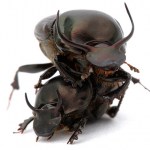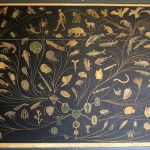phylogeny
In my last post, I wrote about insulin and interesting features of the insulin structure. Some of the things I learned were really surprising. For example, I was surprised to learn how similar pig and human insulin are. I hadn't considered this before, but this made me wonder about the human insulin we used to give to one of our cats. How do cat and human insulin compare?
It turns out, that all vertebrates produce insulin, even frogs and zebra fish. Human preproinsulin is only 110 amino acids long and even human and fish insulin are pretty similar…
On Tetrapod Zoology, Darren Naish acquaints us with all manner of vesper bats, a group which comprises 410 of the 1110 bat species worldwide. In Part I, Darren provides an overview of the group as a whole, including their snub-nosed morphology, invertebrate eating habits, echolocation frequencies, and migratory tactics, which may have "evolved at least six times independently." In part III, he looks at a sister group to vesper bats called bent-wing bats, which "have the smallest reported genome of any mammal: it's about half average size." And in part VII, Darren explains that desert long-…
Leptomyrmex darlingtoni, Australia
A big day for ant evolution! The Ant Tree of Life research group (AToL) has published their dolichoderine phylogeny in the journal Systematic Biology.
Dolichoderines are one of the big ant subfamilies, comprising just under ten percent of the world's ant species. These are dominant, conspicuous ants noted for having ditched the heavy ancestral ant sting and armor in favor of speed, agility, and refined chemical weaponry. Most dolichoderines live in large colonies with extensive trail networks, and they fuel their frenetic lifestyle through copious…
A clarification, relevant the discussion below:
Tree from Brady et al 2006.
tags: Tree of Life, conservation, biodiversity, ecology, evolution, biology, statistics, teaching, streaming video
This video presents a very brief glimpse into what I do as a professional researcher studying "my birds" -- the parrots of the South Pacific Ocean (during those rare and beautiful times when I actually have a job!!). To say the least, it fills me with intense longing to reclaim my long lost life.
tags: Tree of Life, conservation, biodiversity, ecology, evolution, biology, statistics, teaching, streaming video
This video presents a very brief glimpse into what I do as a professional researcher studying "my birds" -- the parrots of the South Pacific Ocean (during those rare and beautiful times when I actually have a job!!). It features interviews with one of the scientists whom I worked with when I was in grad school at the University of Washington: Scott Edwards, who now is at Harvard University. To say the least, this video fills me with intense longing to reclaim my long lost life…
I see that the TimeTree of Life project is now public. This collaborative project draws on the research of dozens of biologists to estimate the timing of past evolutionary divergences. The work is available as a book, but the online version has an interactive section that allows the user to name two organisms and get back the date the two last shared an ancestor.
For instance,
Ants vs. Bees: 163.5 million years ago
A word of caution, though. While the output is extremely precise (i.e., it gives exact dates with decimal places), precision is not necessarily accuracy.…
I saw this short video at a conference last year and was entranced. The clip shows how the ancestral arachnid body plan changed as it evolved through various descendant lineages.
Pyramica (or is it Strumigenys?) rostrata, Illinois
I've been thinking today about the Wikipedia edits to the Pyramica page, and my curiosity about the controversy prodded me to attempt a quick phylogenetic analysis. Before I get to the analysis, though, here is some background.
The Ants. Forests in warmer regions around the world hold a great number of tiny, sluggish ants covered with bizarre hairs of unknown function. These oddly ornate little insects are predators of other arthropods. Mites, springtails, and the like. Because of their size, their…
What tells us that this new form of H1N1 is swine flu and not regular old human flu or avian flu?
If we had a lab, we might use antibodies, but when you're a digital biologist, you use a computer.
Activity 4. Picking influenza sequences and comparing them with phylogenetic trees
We can get the genome sequences, piece by piece, as I described in earlier, but the NCBI has other tools that are useful, too.
The Influenza Virus Resource will let us pick sequences, align them, and make trees so we can quickly compare the sequences to each other.
This is how I got the sequences that I wrote about…
This afternoon, I was working on educational activities and suddenly realized that the H1N1 strain that caused the California outbreak might be the same strain that caused an outbreak in 2007 at an Ohio country fair.
UPDATE: I'm not so certain anymore that the strains are the same. I'm doing some work with nucleic acid sequences to look further at similarity.
Here's the data.
Once I realized that the genome sequences from the H1N1 swine flu were in the NCBI's virus genome resources database, I had to take a look.
And, like eating potato chips, making phylogenetic trees is a little bit…
...these would be the beetles of choice.
Onthophagus taurus dung beetles,
showing size and horn variation among males.
Dung beetles in the widespread genus Onthophagus sport a bewildering array of horns. Not only do the horns of different species vary in shape, size, and the body part from which they grow, many species show a marked dimorphism within the males.
Consider these two male morphs of O. nigriventris, an African species:
The big guy on the right is a major male, and he does pretty much what you'd expect. He bullies his way around with shows of bravado, guarding his burrows…
This beautiful painting is located in Martin Hall at Swarthmore College. Discovered via Colin Purrington's flickr feed.
tags: lories, Loriinae, Loriidae, ornithology, molecular biology, natural history museums
A young pair of Meyer's Lories (Lorikeets), Trichoglossus flavoviridis meyeri.
Image: Iggino [larger view].
"Can you help us identify a mystery lory in our collection?"
I was pleasantly surprised to find this email request from Donna Dittmann, Collections Manager and Museum Preparator for the Section of Genetic Resources at Louisiana State University Museum of Natural Science in Baton Rouge, Louisiana.
"Sure," I wrote back. "Send it to me and I'll see what I can do."
I, and some of my lories,…
Sixty-five million years ago, life on Earth was sorely tested. One or more catastrophic events including a massive asteroid strike and increased volcanic activity, created wildfires on a global scale and dust clouds that cut the planet's surface off from the sun's vital light. The majority of animal species went extinct including, most famously, the dinosaurs. The fate of the planet's plants is less familiar, but 60% of those also perished. What separated the survivors from the deceased? How did some species cross this so-called "K/T boundary"?
Jeffrey Fawcett form the Flanders Institute for…
Simopelta sp. nr. pergandei, Venezuela
I've just started a project in collaboration with Daniel Kronauer, Jack Longino, and Andy Suarez to infer the phylogeny of species in the Neotropical ponerine genus Simopelta. If you happen to have any DNA-quality specimens of these unusual ants in your keep, we'd greatly appreciate a donation.
Why Simopelta? These insects are among the "other" army ants, the barely-known lineages that have also evolved the specialized nomadic lifestyle that characterizes the well-known, photogenic, and oft-televised ecitonine and doryline army ants.…
Explaining the evolutionary tree of life is always a tricky proposition, as narratives are inherently linear but evolution spirals outwards in countless messy directions at once. To tell a story from the tangled bank requires picking a single thread and following it, yet it is precisely our tendency to follow single threads that causes so much misunderstanding of how evolution works.
Attenborough grapples with the problem using an animation that permeates the video, showing graphically the complexity of an ever dividing tree in the background as he traverses time from ancient to…
The area collectively known as Austronesia covers half the globe. It stretches from South-East Asia and Taiwan, across New Guinea and New Zealand, to the hundreds of small islands dotted around the Pacific. Today, it is home to about 400 million people.
They are the descendants of early humans who spread throughout the Pacific in prehistoric times. These forebears are long dead but they left several unexpectedly important legacies that are evident in their modern descendants. The languages they used evolved and splintered into over 1,200 tongues spoken by modern Austronesians. The bacteria…
Scientists have long been torn about the exact evolution of birds since fossil and molecular dating techniques have yielded different answers. But by studying the DNA of birds in the parrot and cockatoo families, which do not migrate like most other birds, researchers were able to discern the times of species divergence and concluded that "parrots are an ancient lineage without any close evolutionary relationships," according to ScienceBlogger Grrl Scientist.
tags: evolution, Phylogeny, ornithology, chemical defense, Batrachotoxin, poisonous birds, Pitohui, Ifrita, Pachycephalidae, New Guinea
The Hooded Pitohui, Pitohui dichrous,
endemic to New Guinea, is very unusual
because it has poisonous plumage and skin.
Image: John Dumbacher.
I have been in love with New Guinea since I first read about it as a kid. Everything about this tropical island is exotic and fascinating to me, from the large numbers of endemic bird and plant species to the tremendous number of spoken languages -- more than anywhere else on the planet. So I was immediately…




